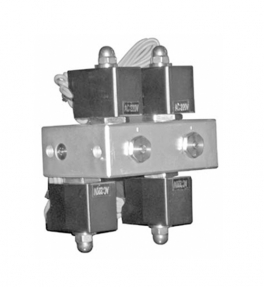
The cold solenoid valve is an industrial equipment controlled by electromagnetic force. It is used to adjust the direction, flow rate, speed and other parameters of the medium in the industrial control system. What should we do if the refrigeration solenoid valve fails? Summarize the causes and solutions of the refrigeration solenoid valve failures, hoping to provide you with help.
Fault phenomenon 1: solenoid valve does not work after power on.
Removal methods: check whether the power supply wiring is bad reconnection and connection of connectors, check whether the power supply voltage is within working range - adjusting the normal position range, whether the coil is de-welded re-welded coil short circuit replacing the coil, whether the working pressure difference is inappropriate adjusting the pressure difference or replacing the proportional solenoid valve, current. Excessive body temperature replacement of the appropriate solenoid valve, impurities make the main valve core and moving iron core of the solenoid valve stuck cleaning. If the seal is damaged, the seal should be replaced and the filter installed. The liquid viscosity is too high, the frequency is too high and the service life has reached replacement of products.
Fault phenomenon two: solenoid valve can not be closed.
Removal method: the seal of main valve core or iron moving core has been damaged replaced seal, whether the fluid temperature and viscosity are too high replaced counterpart solenoid valve, impurities enter solenoid valve to produce valve core or iron moving core to clean, spring life has reached or deformed replaced, balance hole of throttle hole is blocked timely cleaning, working frequency Too high or life expectancy.
Other failures:
Internal leakage to check whether the seal is damaged, and whether the spring is assembled badly.
Leakage: connect loosening or seal is broken. Tighten screws or replace seals.
There is noise when power is switched on, and the fastener on the head is loose and tightened.
Voltage fluctuation is not within the allowable range, adjust the voltage. Clean or replace the impurities or uneven surfaces of the core.
Example: common faults and elimination of electromagnetic reversing valve of air conditioner
Electromagnetic reversing valve is an electromagnetic control switching valve for refrigeration and heating of heat pump air conditioner, which belongs to two-position four-way valve. It consists of three parts: main valve, pilot valve and electromagnetic coil. It is the most complex and precise part in the refrigeration system of air conditioner, besides compressor. It is also a part which is difficult to check and repair, and it is difficult to judge the quality and troubleshoot. In addition to the control circuit fault, the common faults are valve core inactivity, blockage and leakage, which cause the slider inactivity or inadequate action, etc.
Fault phenomenon three, solenoid valve does not change direction.
If the solenoid valve core or slider can not move and is fixed in a position, the refrigeration or heating of the air conditioner can not be converted to each other. Generally, the most common faults are only refrigeration, not heating, while causing air conditioner blown cold air protection, outdoor unit operation, indoor unit does not blow hot air, stop after showing fault lights.
Fault phenomenon four. Solenoid valve coil short circuit
When the air conditioner converts to heating operation, the current of solenoid valve coil is too large due to short circuit. When serious, it burns the fuse on the main control board or causes tripping, resulting in the whole machine can not work properly.
Fault phenomenon five. Deformation of solenoid valve slider
If the slider is deformed, even if the solenoid valve coil is electrified, the guide valve core will not move, resulting in the failure of the slider to change direction, causing the valve body to cross air, compressor high-pressure gas to form a short cycle, causing high temperature, high pressure, until frequent thermal protection, and ultimately burning the compressor insulation layer. For the whole system, the high pressure of the cut-off valve leaks to the low pressure end, and the high / low pressure difference decreases. It often appears to be unrefrigerant, not heating or poor.
Causes and troubleshooting methods:
1. when the solenoid valve is open, short circuited or burned, the valve core can not be absorbed, causing the slider not to act. It should be replaced.
2. the solenoid valve is blocked and the valve core can not act, causing the slider to not move. The valve body can be cleaned and adjusted.
3. When the power supply voltage is lower than the rated value of solenoid valve, the pressure difference between the inlet and outlet of solenoid valve exceeds the opening capacity. At this time, the valve often emits "beep" noise, which causes the valve core not to close. Power supply should be improved.
4. solenoid valve flow reversal installed, causing the valve does not move. Flow direction should be adjusted.
5. the system has high temperature, high pressure and impurities in the machine, resulting in deformation and clamping of the slider. It should be replaced.
6. remanent suction valve core or valve heart is stuck, after the power failure, the solenoid valve can not be closed. Cleaning adjustment, such as no effect replacement.
7. solenoid valve gasket damage or fastening screws loose, causing refrigerant leakage. Change the gasket and tighten the screws.
8. the capillary on the valve is blocked or broken, or the serious leakage of the system causes the slider to not act. Clean the capillary or weld the copper tube slightly thicker than the broken capillary tube.
The 9. valve is dirty, valve seat or valve pin damaged and spring force is too small, resulting in electromagnetic valve closes lax. Clean and adjust or replace springs.
In addition, if the internal leakage of the reversing valve causes the leakage of high-pressure refrigerant gas to the low-pressure side, and the normal pressure can not be established at both ends of the piston of the reversing valve, the reversing valve should be replaced. If the pressure difference of the refrigeration system is too large to make the reversing valve reversible, it is necessary to check the pressure of the refrigeration system or find the leakage point, and fill the refrigerant. If the slider of four-way valve does not move or does not move properly, the screwdriver wooden handle can be used to check and judge, tap the valve body gently, and turn on or off the AC 220V power supply from time to time. Repeat several times. When the armature absorption sound and the gas reversing sound in the valve body are heard, the reversing valve can be basically restored to normal work.





